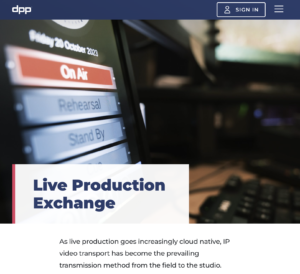Categories
Archives
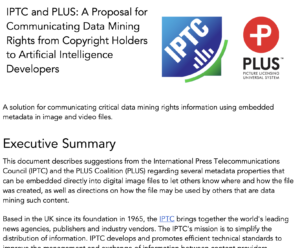
Together with partner organisation the PLUS Coalition, the IPTC has submitted a response to the UK Intellectual Property Office’s consultation on Copyright and Artificial Intelligence.
Our position can be summarised as the following:
- On behalf of our memberships, IPTC and PLUS respectfully suggest that existing UK copyright law is sufficient to enable licensing of content to AI platforms. There is no “fair use” provision in UK copyright law, and “fair dealing” does not cover commercial AI training. Existing copyright law should be enforced.
- IPTC and PLUS Photo Metadata provide a technical means for expressing the creator’s intent as to whether their creations may be used in generative AI training data sets. This takes the form of metadata embedded in image and video files. This solution, in combination with other solutions such as the Text and Data Mining Reservation Protocol, could take the place of a formal licence agreement between parties, making an opt-in approach technically feasible and scalable.
- It is true that our technical solutions would also be relevant if the UK government chooses to implement an “opt-out” approach similar to that adopted in the EU. However, an opt-out-based approach does not currently protect owners’ rights well, due to the routine activity of “metadata stripping” – removing important rights and accessibility metadata that is embedded in media files, in the misguided belief that it will improve site performance. Metadata stripping is performed by many publishers and publishing systems – often inadvertently. (See our research on metadata stripping by social media platforms from 2019; very little has changed since then)
- As a result, we can only recommend that the UK adopts an opt-in approach. We request that the UK ensures metadata embedded in media files be declared as a core part of any technical mechanism to declare content owner’s desire for content to be included or excluded from training data sets.
During the course of this consultation, it has become clear that content creators are a core part of the UK economy and have a strong voice. We agree with their position, but we don’t simply come with another voice of complaint: we bring a viable, ready-made technical solution that can be used today to implement true opt-in data mining permissions and reservations.
The full document in PDF form can be viewed here:

The IPTC Sports Content Working Group is proud to release version 1.1 of IPTC Sport Schema.
Documented at the dedicated site sportschema.org, Sport Schema is IPTC’s semantic web (RDF) based ontology for describing sports listings, results, statistics and even play-by-play actions during any kind of sports event.
Version 1.1 adds the following new features:
- We add a Club type, which can handle the organisation that hosts one or more teams of varying types, possibly across various sports. (Did you know that Bayern Munich has not just the famous men’s, women’s and junior football/soccer teams, but also basketball, handball, table tennis and even chess teams!)
- We also add a TeamMembership type, so a Team can be a member of a Club (and could theoretically move from one Club to another).
- We add support for the concept of “sports facets” that we originated in SportsML. (based on SportsML / NewsCodes facets) so we can now say that an event is “women’s 400 metres relay swimming”, not just “swimming”. The boxing example shows that the weight class of the event is “welterweight”.
- Added the ability to link from Athlete to Team via a new teamParticipation property.
- Add an AssociateMembership type so an Associate (such as a coach) can have a tenure relating to any Agent, including an Athlete or a Team. Previously Associates were linked to Teams via Participation objects which wasn’t satisfactory.
- Expanded and added to examples including a Boxing example showing how the new AssociateMembership type can be used to represent a coach or manager of an individual athlete (in this case a boxer)
- Added new golf ontology taking some properties from SportsML and some from the Golf vocabularies in IPTC NewsCodes. We have merged them together in Sport Schema for ease of use.
- Many cleanups to the SHACL Shapes used for validation of data.
Please take a look at Sport Schema and let us know what you think! We would love to hear about Sport Schema being implemented in real-world projects. Please contact IPTC using the Contact Us form or via the public discussion list at groups.io/g/iptc-sportsml/
2024 has flown by, but it was a great year for IPTC.
The highlight was definitely the creation of the IPTC’s first new Committee in many years – the Media Provenance Committee, with its working groups for Advocacy and Education, Best Practices and Implementation, and Governance.
Thanks to our Committee Chair Bruce MacCormack (and previous Chair Judy Parnall), and Working Group leads Helge O. Svela, Laura Ellis and Charlie Halford for all their hard work.
With the Committee we launched the Origin Verified News Publisher List this year, with demos and events at IBC in September and NAB New York in October.
The Media Provenance Summit held in the UK in October drew over 70 representatives from news organisations from Africa to Iceland to understand what we are doing in the area of C2PA and media provenance. Thanks to the BBC and Media Cluster Norway for organising the event.
The Committee’s latest milestone is the updating of its governance guidelines to make it easier for Verified News Publishers to obtain certificates. More information will be announced very soon.
Our other Working Groups under the Standards Committee have not been idle – this year has seen new versions of NewsML-G2, ninjs 3.0, Photo Metadata 2024.1, several updates to our NewsCodes vocabularies, including updates to the widely-used Digital Source Type vocabulary, and a forthcoming update to Sport Schema.
Our standards are being used by many of the biggest organisations in the world. Google uses IPTC metadata for AI transparency (among other things). Axel Springer spoke at our Autumn Meeting about how they use Video Metadata Hub to manage their Video On Demand system. AFP and Kairntech talked about how they auto-classify content using Media Topics. And many more of course!
We published advice on using IPTC Photo Metadata for AI-generated images as part of an update to the Photo Metadata User Guide – both to mark their creation and to declare the owner’s intent on whether the image should be used as part of a training data set.
Our partnerships have never been stronger. We signed new liaison agreements with CIPA, EIDR and Global Media Registry. Our latest collaboration with DPP was the Live Production Exchange project, based on IPTC’s ninjs 3.0 standard.
We submitted position papers to the IETF workshop on AI Control and to the EU’s consultation on the AI Act, making the case for respecting embedded metadata in determining whether media files can be used as training data for AI engines.
We had many new members join: Google, Finnish Broadcasting Company Yle, HAND (Human & Digital), China Association of Press Technicians, Kairntech, DW (Deutsche Welle), Factiverse, Media Cluster Norway, RNZ, John Simmons. European Broadcasting Union (upgraded to Voting Membership), and Trufo. We’re very happy to have you all onboard!
We had two amazing member meetings: one physical meeting in New York (thanks to The New York Times and The Associated Press for hosting us) and one virtual meeting in the Autumn. Our attendees especially loved the guides tours of the NYT and AP archives. We’re already planning the next Spring Meeting which will be held in Juan-les-Pins, France in May 2025.
The IPTC Photo Metadata Conference in May saw Adobe, Camera Bits, Foto Forensics, Numbers Protocol and others present many aspects of photo metadata to celebrate 20 years of the IPTC Photo Metadata Standard.
We gave presentations about IPTC standards in the Netherlands, UK, Brazil, USA and France – and probably other places too!
Here’s to achieving even bigger things in 2025!
Thanks for all your help and support.
At the IPTC Autumn Meeting, the IPTC Standards Committee voted on a change proposed by the Photo Metadata Working Group, which created version 2024.1 of the IPTC Photo Metadata Standard.
The change is minor but important to some: the definition of the Keywords property now includes the following text:
Keywords to express the subject and other aspects of the content of the image. Keywords may be free text and don’t have to be taken from a controlled vocabulary. Codes from the controlled vocabulary IPTC Subject NewsCodes must go to the “Subject Code” field.
This aligns the property definition with the way in which many photo agencies and photographers were already using the field: to convey aspects such as the lighting or lens effects used, “mood” of the image, dominant colour and more.
We give examples of how the Keywords property may be used in the IPTC Photo Metadata User Guide.
The relevant files have all been updated for the new version:
- The IPTC Photo Metadata Standard Specification
- The IPTC Photo Metadata User Guide
- The IPTC Photo Metadata TechReference, in both YAML and JSON formats
- The IPTC Photo Metadata Reference Image
We thank Agence France-Presse for their help in offering examples for how the Keywords property may be used.
The IPTC has worked together with the DPP and stakeholders from Reuters, Arqiva and Warner Brothers Discovery to develop a pioneering new initiative called DPP Live Production Exchange (LPX). The LPX protocol covers API and a data schema for information related to news coverage of live events, including the ability for B2B event subscribers to be informed about upcoming news events and their coverage.
IPTC’s contribution to the project was to enhance and evolve our ninjs (News in JSON) standard to support news coverage of events and live streamed content. The News in JSON Working Group dedicated a lot of its time to this work over the past two years, including participating in the DPP LPX Hackathon in Spring 2024.
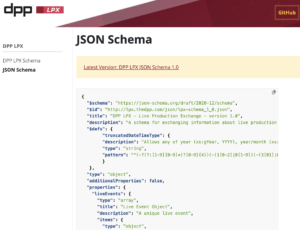
The underlying data model for the events and planning work in ninjs comes from the IPTC News Architecture and is based on EventsML-G2, a part of the NewsML-G2 family of standards which was created over 10 years ago.
Ian Young of PA Media, Lead of the IPTC News in JSON Working Group, said “Basing the work of ninjs 3.0 on the stable foundation of the IPTC News Architecture made our work much simpler. IPTC members have been syndicating news events for years using this model so we know that it works. That meant that we could focus on making ninjs 3.0 handle live events and streaming video in a way that is practical and simple, both for developers and for users.”
IPTC Managing Director Brendan Quinn said “we owe our thanks to our teammates and partners on this project: David Thompson from IPTC liaison partners the DPP, JJ Eynon from CNN / Warner Brothers Discovery, Tania Vivero and Ian McLaren from Reuters (IPTC Voting Member), and Daniel Lynch from Arqiva (IPTC Associate Member). Through a very friendly and collegial but also productive and results-driven collaboration, we have arrived at a solution that should make syndicated news events much easier to handle in all newsroom workflows.”
ninjs 3.0 and the LPX API are or will soon be supported by tools from Arqiva, Reuters and Wolftech (who were recently acquired by Avid). We hope that many more implementations will be emerge in the coming months.
For more on ninjs 3.0, see the following resources:
- IPTC’s pages on ninjs (News in JSON)
- The ninjs generator tool, a simple form that generates sample ninjs documents in versions 1.5, 2.1 and 3.0
- The IPTC’s ninjs GitHub repository
- IPTC members regularly discuss ninjs at our News in JSON Working Group meetings and on the members-only News in JSON WG discussion group.
- Non-members are welcome to discuss ninjs at the public ninjs discussion group.

The IPTC is happy to announce that EIDR and IPTC have signed a liaison agreement, committing to work together on projects of mutual interest including media metadata, content distribution technologies and work on provenance and authenticity for media.
The Entertainment Identifier Registry Association (EIDR) was established to provide a universal identifier registry that supports the full range of asset types and relationships between assets. Members of EIDR include Apple, Amazon MGM Studios, Fox, the Library of Congress, Netflix, Paramount, Sony Pictures, Walt Disney Studios and many more.
As EIDR said in their release:
EIDR’s primary focus is managing globally unique, curated, and resolvable content identification (which applies equally to news and entertainment media), via the Emmy Award-winning EIDR Content ID, and content delivery services, via the EIDR Video Service ID. In support of this, EIDR is built upon and helps promulgate the MovieLabs Digital Distribution Framework (MDDF), a suite of standards and specifications that address core aspects of digital distribution, including identification, metadata, avails, asset delivery, and reporting.
IPTC’s Video Metadata Hub standard already provides a mapping to EIDR’s Data Fields and the MDDF fields from related organisation MovieLabs. The organisations will work together to keep these mappings up-to-date and to work on future initiatives including making C2PA metadata work for both the news and the entertainment sides of the media industry. IPTC members have already started working in this area via IPTC’s Media Provenance Committee.
“In the Venn diagram of media, there is significant overlap between news and entertainment interests in descriptive metadata standards, globally-unique content identification, and media provenance and authenticity,” said Richard W. Kroon, EIDR’s director of technical operations. “By working together, we each benefit from the other’s efforts and can bring forth useful standards and practices that span the entire commercial media industry.
“Our hope here is to find common ground that can align our respective metadata standards to support seamless metadata management across the commercial media landscape.”

In October 2024, 70 people representing 30 organisations from 15 countries across four continents gathered at the BBC building in Salford to join the Origin Media Provenance Seminar. The seminar was organised by BBC R&D with partners from Media Cluster Norway (MCN) in Bergen.
Media provenance is a way to record digitally signed information about the provenance of imagery, video and audio – information (or signals) that shows where a piece of media has come from and how it’s been edited. Like an audit trail or a history, these signals are called ‘content credentials’, and are developed as an open standard by the C2PA (Coalition for Content Provenance and Authenticity). Content credentials have just been selected by Time magazine as one of their ‘Best Inventions of 2024’.
Attendees came from all over the world, including the US, Japan, all over Europe, and also sub-Saharan Africa.
According to the BBC blog post:
In order for news organisations to show their consumers that they really are looking at some content from the real “BBC”, content credentials use the same technology as websites – digital certificates – to prove who signed it. The International Press Telecommunications Council (IPTC) has created a programme called “Origin Verified News Publishers”, which allows news organisations to register to get their identity checked. Once their ID has been verified, they can get a certificate, which gives consumers assurance that the content certifiably comes from the organisation they have chosen to trust.
For more information about the event, see the blog post on the BBC Research & Development blog.
For more information about the IPTC Origin Verified News Publishers List, please see the Media Provenance section of the IPTC website or contact the IPTC directly.

On Thursday, Google announced that it will be extending its usage of AI content labelled using the IPTC Digital Source Type vocabulary.
We have previously shared that Google uses IPTC Photo Metadata to signal AI-generated and AI-edited media, for example labelling images edited with the Magic Eraser tool on Pixel phones.
In a blog post published on Friday, John Fisher, Engineering Director for Google Photos and Google One posted that “[n]ow we’re taking it a step further, making this information visible alongside information like the file name, location and backup status in the Photos app.”
This is based on IPTC’s Digital Source Type vocabulary, which was updated a few weeks ago to include new terms such as “Multi-frame computational capture sampled from real life” and “Screen capture“.
Google already surfaces Digital Source Type information in search results via the “About this image” feature.
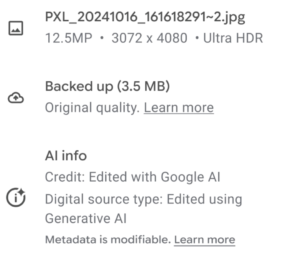
Also, the human-readable label for the term http://cv.iptc.org/newscodes/digitalsourcetype/trainedAlgorithmicMedia was clarified to be “Created using Generative AI” and similarly the label for the term http://cv.iptc.org/newscodes/digitalsourcetype/compositeWithTrainedAlgorithmicMedia was clarified to be “Edited with Generative AI.” These terms are both used by Google.
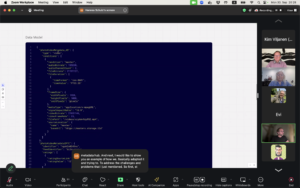
Last week we held the latest IPTC member meeting, the IPTC Autumn Meeting 2024. With over 80 attendees, it was a great success. We heard from IPTC members and invited guests on new developments in the world of media technology and metadata.
Speakers from Axel Springer, Reuters, Global Media Registry and the EBU
We heard from Axel Springer who have implemented an internal video management system based on IPTC Video Metadata Hub as a metadata model; from Reuters who are basing their live events streaming API on the forthcoming DPP Live Production Exchange (DPP LPX) protocol based on the recently approved ninjs 3.0, from Global Media Registry who are developing a “Unique Media ID” standard to identify media publishers, and from the EBU on the Trusted European Media Data Space (TEMS) project.
Committees and Working Groups
Our new Media Provenance Committee and its Working Groups are working very hard on the details for implementing C2PA in the media industry, including launching the IPTC Origin Verified News Publisher List. We also heard from Tessa Sproule of CBC / Radio Canada on their implementation of C2PA.
Our Standards Committee Working Groups are also working hard, with new developments on all of our standards and three new standard versions, as described below.
New Versions of Sport Schema, ninjs and Photo Metadata
The Standards Committee approved three new standard versions at its meeting on Wednesday 2nd October.
IPTC Sport Schema version 1.1 was approved, adding a Club class so we can model Clubs that contain multiple Teams, even teams that play different sports (who knew that Bayern Munich had a chess team?!). The update also added Associate relationships for individual athletes (such as a coach for a tennis player or a boxer), and facets for sports so we can now declare that an event was a women’s 200 metres breaststroke swimming event using IPTC facets metadata taken from our NewsCodes sports facet vocabulary.
IPTC Photo Metadata Standard version 2024.1 modifies the text of the Keywords property to broaden its scope, matching current industry usage.
IPTC’s JSON standard for news ninjs version 3.0 was also approved, adding requirements for the DPP LPX project including events and planning information, plus renditions support for live event streams. The 3.0 version of the standard also moves property names to “camelCase”, which is the de facto standard for GraphQL and many other JSON-based technologies.
All three updates, plus the NewsML-G2 v2.34_2 errata update, will be released in the coming weeks.
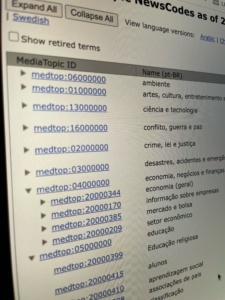
The IPTC NewsCodes Working Group is pleased to announce the latest release of the IPTC NewsCodes, our set of controlled vocabularies for the news industry.
Updates this time span many vocabularies, with the biggest updates to Media Topic and Digital Source Type.
Media Topic updates
Most of the recent work has been in the politics branch.
3 new concepts: by-election, recall election, coalition building
2 retired concepts: political campaigns, church elections
4 modified concept names (in English): voting system, referendum, fundamental rights, football (yes we finally refer to the sport as “football” in en-GB and “soccer” in en-US!)
Modified concept definitions: 22 civil rights, election, voting system, intergovernmental elections, local elections, primary elections, referendum, regional elections, voting, fundamental rights, censorship and freedom of speech, freedom of religion, freedom of the press, human rights, football, political debates, privacy, women’s rights, breaking (breakdance)
1 hierarchy move: fundamental rights has been moved from politics to society.
Also, the Wikidata mapping URIs have all been changed to point to the http:// version of the URI instead of the https:// version. This follows the official Wikidata guidance.
See the official Media Topic vocabulary on the IPTC Controlled Vocabulary server, and an easier-to-navigate tree view. An Excel version of IPTC Media Topics is also available.
Digital Source Type updates
5 new concepts have been added:
- Multi-frame computational capture sampled from real life, intended to cover media recorded by modern cameras and smartphones that may process several captured images together to create the saved media file, without any interaction with the photographer.
- Human-edited media, intended to replace the retired Original media with minor human edits, given that it is subjective to decide what is a “minor” edit.
- Digital creation, intended to replace the retired Digital art so that we can avoid the existential question of “what is art?”
- Screen capture, covering screenshots and screen recordings made on a device
- Composite of elements, as a generic form of the more specific “composite” terms.
2 concepts have been retired: Original media with minor human edits, and Digital art, as explained above.
8 concepts have had their names and definitions modified, while retaining the same machine-readable ID for backwards-compatibility purposes:
- Digital capture sampled from real life (ID: digitalCapture), replacing the previous name “Original digital capture sampled from real life”
- Digitised from a transparent negative (ID: negativeFilm), replacing the previous name “Digitised from a negative on film”
- Digitised from a transparent positive (ID: positiveFilm), replacing the previous name “Digitised from a positive on film”
- Digitised from a non-transparent medium (ID: print), replacing the previous name “Digitised from a print on non-transparent medium”
- Edited using Generative AI (ID: compositeWithTrainedAlgorithmicMedia), replacing the previous name “Composite with Trained algorithmic media”
- Algorithmically-altered media (ID: algorithmicallyEnhanced), replacing the previous name “Algorithmically Enhanced”
- Created using Generative AI (ID: trainedAlgorithmicMedia), replacing the previous name “Trained Algorithmic Media”
- Virtual event recording (ID: virtualRecording), replacing the previous name “Virtual recording”
Our thanks go to IPTC representatives and experts from Partnership on AI, Google, Adobe, C2PA, CIPA and many others on making these updates to our vocabulary, which is now widely used to identify Generative AI content.
Updates to other NewsCodes vocabularies
Alternative Identifier Role (altidrole)
- Vocabulary’s name changed to fix a spelling mistake.
- New concept: IPTC Video Metadata Hub ID (altidrole:vmhVideoId)
Event Occur Status (eocstat)
- Fix spelling mistake “occurence” -> “occurrence” throughout.
Golf Shot (spgolshot)
- New concept: Chip (spgolshot:chip)
Rights Property (rightsprop)
- New concept: Copyright Year (rightsprop:copyrightyear)
- 4 modified definitions: Minor Model Age Disclosure, Model Release Id, Model Release Status, Property Release Status.
Sports Concept (spct)
- New concept: Recurring Competition (spct:recurring-competition)
- New concept: Governing Body (spct:governing-body)
